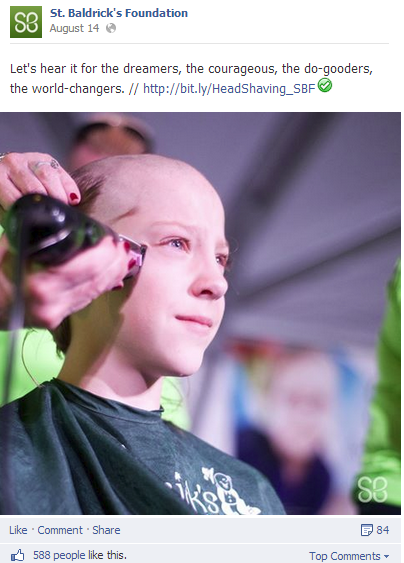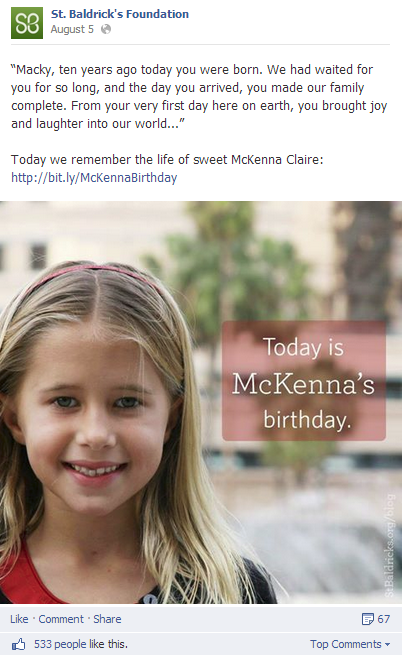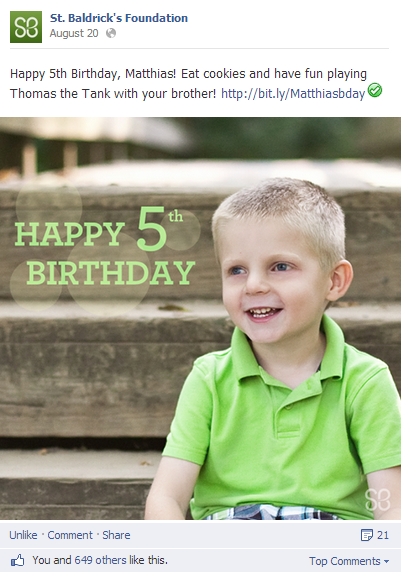Case Study: How One Nonprofit Raised Thousands Using Facebook – Part 1
 I first became aware of the St. Baldrick’s Foundation at the Inspire/BIO Conference in July.
I first became aware of the St. Baldrick’s Foundation at the Inspire/BIO Conference in July.
I was asked to speak about the latest social media tools for nonprofits, but I found myself learning even more from the other presenters – nonprofit professionals in the trenches who use social media every day to change the world.
One of the best examples of a nonprofit effectively harnessing the power of social media is the St. Baldrick’s Foundation. A volunteer-driven organization, St. Baldrick’s is committed to funding the most promising research to find cures for childhood cancers and give survivors long and healthy lives.
If you doubt the power of video to tell a nonprofit’s mission, watch this.
The video was created with the goal of making a seemingly insurmountable problem seem tangible to the average donor – to make them believe that they can make a difference.
The video encompasses the digital communications strategy of the organization – Educate, inform, delight, and create trust and affinity.
But what about using social media to get people excited about childhood cancer research?
Childhood cancer is very heavy topic that would not, on the surface, lend itself well to social media.
As we all know, social media, especially Facebook, trends towards the light and carefree – cat memes, slapstick videos and food porn.
Can a nonprofit dealing with childhood cancer research raise money and awareness using Facebook? The answer is yes!
I spent some time talking with Natalie Stamer, St. Baldrick’s Director of Digital Communication Strategy, to discuss their social media strategy and how they managed to raise over $12,000 this year just using Facebook.
What are their secrets?
1) Have a dedicated, energetic and forward-thinking staff member overseeing social media strategy and implementation.
Stamer is in charge of all digital communications strategy, including the many channels in which St. Baldrick’s is active: website development, blog, email communications, social media.
Her job includes creating content, posting content, responding to questions and comments, researching content and measurement and analysis.
Having at least one person in charge that is willing to challenge the status quo, be an early-adopter and forge ahead with new technology and platforms is key to a nonprofit’s success.
2) If it’s not working, fix it.
Stamer took over St. Baldrick’s social media strategy a year and a half ago, when it was housed in another department.
After analyzing the data and seeing that there was little to no conversation or engagement on their social media channels, she worked on improving the content strategy.
“We were talking at the audience and not talking with them,” said Stamer. “We weren’t delighting our audience – we were just pushing out content that we wanted to say rather than listening to what they wanted to read.”
The change has paid off. Just in the first half of this year, Facebook alone has resulted in over 54,000 website visitors, 606 donations and 223 event participants. The average website donation has a value of $54.42!
3) Be willing to be an early adopter and explore multiple channels.
Facebook was the first platform the charity started using, in late 2008.
St. Baldrick’s is also active on Twitter, Google+, YouTube and Vimeo, and Pinterest.
Because of the results and success they have experienced just this year, their social media efforts have focused mostly on Facebook, but the organization does have future plans to invest more time in Twitter and Instagram.
4) Always post quality content.
The St. Baldrick’s social media philosophy is to always delight first.
To find quality content that would be of interest to their audience, St. Baldrick’s follows others childhood cancer organizations where they partner to share their communications.
They have also found that there are thousands of families of kids with cancer who are interested in sharing their stories – often these families blog themselves, and St. Baldrick’s contacts them to ask them to write something specific to the organization, or republishes their blog and their stories.
“We always think – what is of interest to our audience?” says Stamer.
They also get nonstop story ideas from email and Facebook messages as well as the comments on their posts.
By listening to their audience and how they are engaging with the content already posted, St. Baldrick’s is able to generate new and fresh posts.
5) Quality over quantity.
Eschewing the common social media advice of posting once per day on all social networks, St. Baldrick’s only posts to Facebook a few times per week.
“Our commitment is that we only post great content – we don’t post anything mediocre,” says Stamer.
Nearly every post has a visual attached, and all the visuals are optimized for the channel. Stamer keeps on top of any Facebook changes to ensure that the photos and visuals are in compliance and the optimal size.
6) Be consistent with your brand.
All content, posts and visuals are always in sync with the St. Baldrick’s brand. They do not go off-topic or post something wildly off-brand.
Stamer’s advice is to never post a visual or language that has no connectivity to your brand, as it confuses your audience.
7) Have clear goals.
St. Baldrick’s has a two-pronged goal by which to measure their social media success:
a) Does the content delight the audience?
b) Does it drive them to the website and result in a “conversion”?
If a post, tweet, blog or any other content is not doing those two things, it’s not published.
This strategy has worked. Facebook currently drives 50% of all of the website traffic. a lot of that traffic is generated by our participants, they are out there posting
99% of content posted has a link back to the website (tracked using the free service bit.ly) and one of four main conversion goals that they track: donations, participant sign ups, newsletter sign ups, advocate sign ups.
However, all content goes back to the first and primary goal of delighting the audience. Stamer and her team do not ask their online community every day to donate, become advocates, etc.
The priorities are always to “keep the conversation going, keep the community engaged, and then listen for the opportunities to ask them to do something.”
8) Measure, measure, measure!
Stamer explains that St. Baldrick’s is not “data-driven” but rather “data- informed”.
Data informs all decisions that they make in their social media plans.
They use the free link-shortening and tracking service bit.ly so they can easily track what gets clicked on.
They also use a Google tool called Google Campaign tracking within Google Analytics (for more on Google Campaigns, click here).
Using Google tools, Stamer can easily track where web traffic originated (Twitter, Facebook, etc.), what happened when that visitor entered the website – did they sign up for the email newsletter, did they make a donation, did they bounce immediately?
Stamer said, “We iterate – if one particular type of content isn’t working or resulting in conversion, we don’t post it again.”
Thursday I will post part 2 of the case study, where I will detail how St. Baldrick’s uses Online Brand Ambassadors, their Google AdWords Grant, their plans for the future and Stamer’s advice for nonprofits struggling to find success on social media.



Comments 37
NEW POST –> How One Nonprofit Raised Thousands Using Facebook http://t.co/Dbu0nW8Csb
Social can work. I promise. RT @JuliaCSocial How One #Nonprofit Raised Thousands Using Facebook http://t.co/xMRnIb6PC1
How One Nonprofit Is Raising Thousands Using Facebook http://t.co/WoWrp6Wa3l by @JuliaCSocial
Thanks @JuliaCSocial for a great blog outlining @stbaldricks social media strategy http://t.co/AH9vANumHP
Thanks for the feature, Julia! RT @JuliaCSocial: NEW POST –> How One Nonprofit Raised Thousands Using Facebook http://t.co/MMx736D70Y
RT @StBaldricks: Thanks for the feature, Julia! RT @JuliaCSocial: NEW POST –> How One Nonprofit Raised Thousands Using Facebook http://t.c…
RT @nataliestamer: Thanks @JuliaCSocial for a great blog outlining @stbaldricks social media strategy http://t.co/AH9vANumHP
How One Nonprofit Is Raising Thousands Using Facebook http://t.co/PaWYeHQQjv via @JuliaCSocial
How One Nonprofit Is Raising Thousands Using Facebook http://t.co/Wyi6FCXTHb via @JuliaCSocial
How One Nonprofit Is Raising Thousands Using Facebook http://t.co/f1DwRH1nvj via @JuliaCSocial
How One Nonprofit Is Raising Thousands Using Facebook http://t.co/uOSmAFeYkz via @JuliaCSocial
How One Nonprofit Is Raising Thousands Using Facebook http://t.co/XVrksDhwYi via @JuliaCSocial
How One Nonprofit Is Raising Thousands Using Facebook http://t.co/o62Cca4GS9 via @JuliaCSocial
RT @SarahArrow: How One Nonprofit Is Raising Thousands Using Facebook http://t.co/o62Cca4GS9 via @JuliaCSocial
How One Nonprofit Is Raising Thousands Using Facebook http://t.co/oOTHm0Tuuf via @JuliaCSocial
How One Nonprofit Is Raising Thousands Using Facebook http://t.co/yEqLpm3b2M via @JuliaCSocial
RT @nataliestamer: Thanks @JuliaCSocial for a great blog outlining @stbaldricks social media strategy http://t.co/AH9vANumHP
How One Nonprofit Is Raising Thousands Using Facebook http://t.co/qCSVAfq9Xf via @JuliaCSocial
How One Nonprofit Is Raising Thousands Using Facebook http://t.co/KvPkeGEtON via @JuliaCSocial
RT @jenniferwindrum: How One Nonprofit Is Raising Thousands Using Facebook http://t.co/KvPkeGEtON via @JuliaCSocial
How One Nonprofit Is Raising Thousands Using Facebook http://t.co/mTBAB6EzVC via @JuliaCSocial
How One Nonprofit Is Raising Thousands Using Facebook http://t.co/UQUEcScxgL via @JuliaCSocial
How One Nonprofit Is Raising Thousands Using Facebook http://t.co/fFV5aR9j1V via @JuliaCSocial
How One Nonprofit Is Raising Thousands Using Facebook http://t.co/avgTFXWUHM via @JuliaCSocial
RT @linkedinexpert: How One Nonprofit Is Raising Thousands Using Facebook http://t.co/6hhKnSDnfT via @JuliaCSocial
RT @LinkedInExpert: How One Nonprofit Is Raising Thousands Using Facebook http://t.co/fFV5aR9j1V via @JuliaCSocial
RT @LinkedInExpert: How One Nonprofit Is Raising Thousands Using Facebook http://t.co/fFV5aR9j1V via @JuliaCSocial
How one non-profit raised thousands on Facebook -> http://t.co/MdKK2STUex
How One Nonprofit Is Raising Thousands Using Facebook http://t.co/f1pa2LyYpn via @JuliaCSocial
How One Nonprofit Is Raising Thousands Using Facebook http://t.co/YJYKkwIBIq via @JuliaCSocial
RT @leaderswest: How One Nonprofit Is Raising Thousands Using Facebook http://t.co/YJYKkwIBIq via @JuliaCSocial
RT @JuliaCSocial: NEW POST –> How One Nonprofit Raised Thousands Using Facebook http://t.co/Dbu0nW8Csb
RT @GrizzardComm: Social can work. I promise. RT @JuliaCSocial How One #Nonprofit Raised Thousands Using Facebook http://t.co/xMRnIb6PC1
How One Nonprofit Is Raising Thousands Using Facebook http://t.co/f5IxBzdQnt via @JuliaCSocial
What’s better than a fabulous story @StBaldricks that you learn from? @JuliaCSocial on how to raising $1000s via FB http://t.co/GIXc63C1nj
Pingback: How One Nonprofit Is Raising Thousands Using Facebook (via J. Campbell) – 8 Secrets to Social Media Success | iNotForProfit
Pingback: How To Use Stories To Raise Money On Social Media - Tech Impact Blog - Leaders in Non-Profit Technology